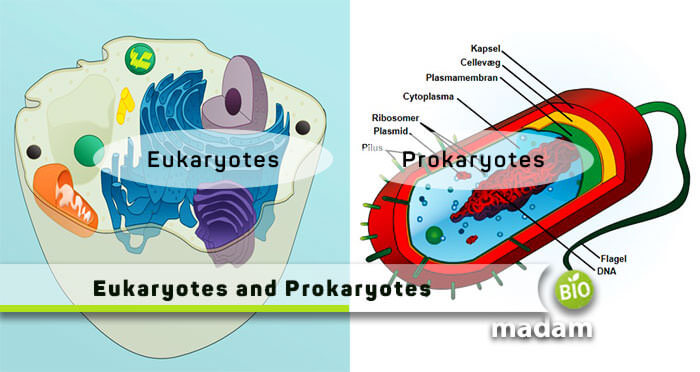Recently updated on December 30th, 2025 at 10:32 pm
If you are confused about how do prokaryotic cells differ from eukaryotic cells, we got your back! Before evolution and natural selection were discovered, life was all about prokaryotes a million years ago. As with the world’s progression, things changed to more complex forms, introducing another organization level, eukaryotes.
Now that we know, all living entities are classified as either eukaryotes or prokaryotes. One can determine the organization level through a species’ cellular structure, as the main difference lies in its composition. The distinguishing features of both these types hold great significance.
Eukaryotes contain all the membrane-enclosed organelles with a distinct nucleus, whereas prokaryotes lack membrane-bounded structures. We will further discuss the differences between the two in detail. But before moving forward, we have enlisted a comparison chart to help you briefly get an overview!
Comparison Chart
| Basis of Comparison | Eukaryotes | Prokaryotes |
| Distinct Nucleus | Present | Absent |
| Complexity | More complex | Simpler organisms |
| Cell Type | Multicellular | Unicellular |
| Membrane-bounded Organelles | Present | Absent |
| Size of Cell | 2-100 µm | 0.5-3 µm |
| Size of Ribosome | Larger subunits (80S) | Smaller subunits (70S) |
| Structure of DNA | Linear structure | Circular |
| Vacuole Functioning | Present | Absent |
| Occurrence of DNA replication | Inside nucleus | In the cytoplasm |
| Examples | Animals, plants, fungi, etc. | Archaea, bacteria, etc. |
Explain Eukaryotes
It is a Greek term consisting of “eu” and “karyon.” The former means true or good, while the latter refers to the kernel (nucleus). It means eukaryotes themselves define all those organisms having a true nucleus. All of the primary kingdom classifications fall under eukaryotes, excluding Kingdom Monera. These are highly complex species with all essential organelles than prokaryotes.
When we observe a eukaryotic cell through a compound or electron microscope, unlike a student light microscope we can see cell walls, cell membrane, distinct nucleus, mitochondria, chloroplast, Golgi apparatus, smooth and rough ER, and several other organelles. However, electron microscopes give a more detailed view than others that give a brief observation.
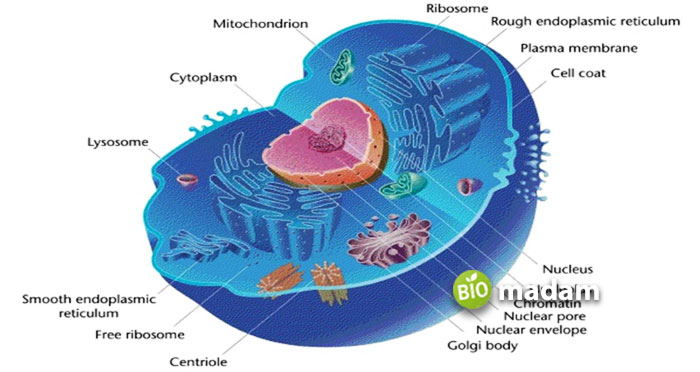
The cell wall protects and supports the plasma membrane surrounding its entire cytoplasm. Animal cell membrane functions to specifically let different substances come in or out of the cell. Furthermore, the nucleus has its own genetic material in the form of DNA and includes a nucleolus. The DNA stores and transmits hereditary characteristics from the parent eukaryotic cell to its daughter cells. It acts to synthesize proteins through ribosomes, which are larger than prokaryotes (the 80S).
A eukaryote also includes mitochondria, which is the energy-house of the cell. It depends on which eukaryotic cell it is, and its reproduction process varies accordingly. They can either reproduce sexually or asexually through the process of meiosis and mitosis, respectively. We can keep on talking on this topic, as eukaryotes cover the maximum number of organisms on this planet, so we’ll end the discussion here to proceed to prokaryotes. In the subsequent headings, we’ve planned to cover the principal differences between eukaryotes and prokaryotes.
Explain Prokaryotes
It is also a Greek term, consisting of two words: “pro” and “karyon.” Pro means before, while the latter holds the same meaning, kernel (nucleus). So, prokaryotes are all living organisms that lack a distinct nucleus. These species are the earliest life forms, existing on the Earth for billions of years ago. Prokaryotes are relatively less complex bodies with no distinct nuclei. If we observe it under a microscope, a prokaryotic cell ranges from just 0.2 to 2-micron meters. Prokaryotes do consist of primitive, micro-compartment of cells, despite being independent of membrane-enclosed organelles.
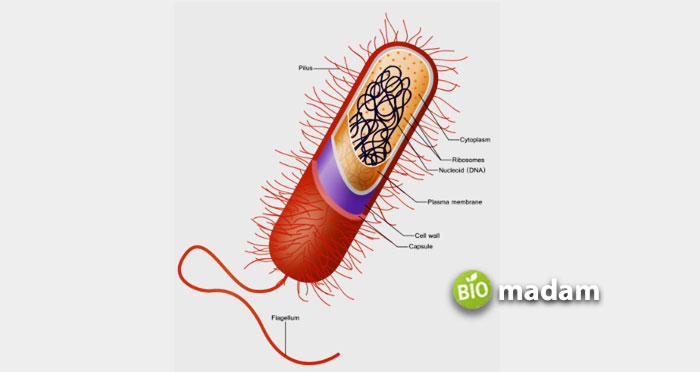
Now, what’s inside this cell? A prokaryotic cell includes water-soluble proteins, active metabolites, cytosol or cytoplasm, and most importantly, the genetic material as DNA, different from the DNA of eukaryotes. A proper cell wall encloses a prokaryote that is made up of peptidoglycans. Cyanobacteria and bacteria are the two famous examples of prokaryotes. They process their lives asexually through the binary fission phenomenon. Generally speaking about its cell wall, a prokaryote classifies as a gram-positive and gram-negative organism. Gram-positive species holds a large amount of peptidoglycan in their cell wall. On the other hand, gram-negative has a relatively thin layer of peptidoglycan. A bacteria (prokaryote) usually appear in four different shapes. These are cocci (spherical-shaped), spirochete (spiral-shaped), vibrio (comma-shaped), and bacilli (rod-shaped). Last but not least, it also contains a flagellum structure, helping in the movement of a prokaryotic cell.
Check Out a Few Similarities Between Eukaryotes and Prokaryotes
- These are the fundamental two types of life forms.
- Both of them carry DNA as their genetic material.
- The cell membrane of both eukaryotes and prokaryotes is composed of a phospholipid bilayer.
- Both the organization levels have ribosomal subunits that help them in protein synthesis.
Grab the Differences Between Eukaryotes and Prokaryotes
Definition
Eukaryotes
This level of life form consists of all organisms acquiring a distinct nucleus and membrane-bounded organelles.
Prokaryotes
This level of life form is particularly set to define organisms with no true nucleus and other organelles.
Complexity
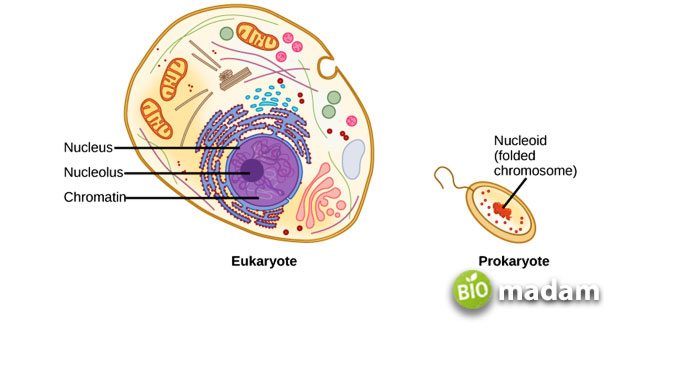
Eukaryotes
These organisms are highly complex living entities.
Prokaryotes
These organisms lack complexity and are comparatively simple.
Relation with the Kingdom
Eukaryotes
The kingdoms, such as Kingdom Plantae, Kingdom Animalia, Kingdom Protista, and Kingdome Fungi, all possess eukaryotes.
Prokaryotes
Kingdom Monera is the only kingdom consisting of prokaryotes in them.
Presence/Absence of Organelles
Eukaryotes
It contains all essential organelles that are bounded by a secure membrane, such as mitochondria in plant cells, ribosomes in plants and animals, Golgi bodies, nuclei, cell walls, endoplasmic reticulum, etc.
Prokaryotes
There is an absence of many organelles in prokaryotes.
Cellular Type
Eukaryotes
These are referred to as multicellular organisms.
Prokaryotes
These are referred to as unicellular organisms.
Individual Cell Size
Eukaryotes
These modified forms of organisms are comparatively larger, varying with a size of 2-100 micron-meter.
Prokaryotes
Such organisms vary from 0.5 micron-meter to 3 micron-meter in size.
DNA Structure
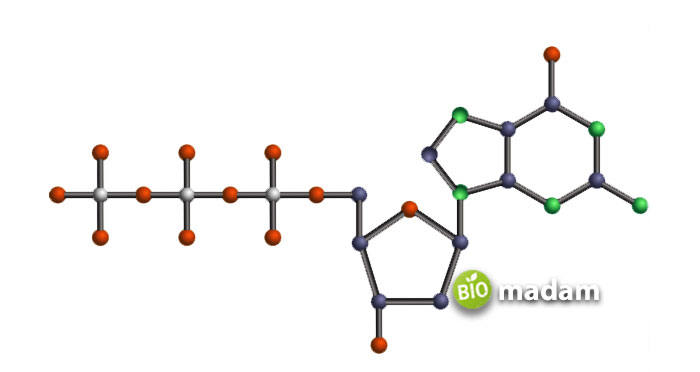
Eukaryotes
These organisms contain several linear chromosomal shapes. The chromosomes consist of introns and exons as well as histone proteins.
Prokaryotes
Prokaryotes are unicellular, so they embrace an individual, circular DNA with no exons or histones.
Method of Reproduction
Eukaryotes
Eukaryotes sexually reproduce their offspring through gamete formation.
Prokaryotes
These living organisms usually reproduce asexually by binary fission or fragmentation. Besides that, some prokaryotes follow the conjugation process of reproduction, which is a sexual method.
Composition of Cell Wall
Eukaryotes
A eukaryotic cell consists of a cell wall with chitin, cellulose, or pectin as its composition.
Prokaryotes
Most prokaryotic cells have cell walls made up of peptidoglycans in either more or less quantity.
Presence of Flagella
Eukaryotes
Most eukaryotes lack flagella due to the presence of cell walls, but a few have them, for example, a sperm cell.
Prokaryotes
Almost all prokaryotes contain flagella for their movement. These are composed of specific types of two proteins These are composed of specific types of two proteins.
Examples
Eukaryotes
Common examples of eukaryotes are Animals, Fungi, Plants, Algae, Mosses, and Protozoa.
Prokaryotes
A few examples of prokaryotes are cyanobacteria, archaea, and bacteria.
Bottom Line
As we all know, a cell is the primary part of every living organism, so its existence and composition matter. It is the reason we thought to clarify the differences between eukaryotes and prokaryotes. Both of these two levels of organizations stand in their significance and efficiency. It’s just that prokaryotes surround all those living bodies whose genetic material is dispersed in the cytoplasm. In contrast, eukaryotes encircle the alive bodies, attaining a true nucleus and distinctive organelles for various purposes.

Hello, I would like to introduce myself to you! I am Chelsea Rogers, an experienced blog writer for science articles, holding an MPhil degree. My enthusiasm to grab the best knowledge, let it relate to botany, zoology, or any other science branch. Read my articles & let me wait for your words s in the comment section.

